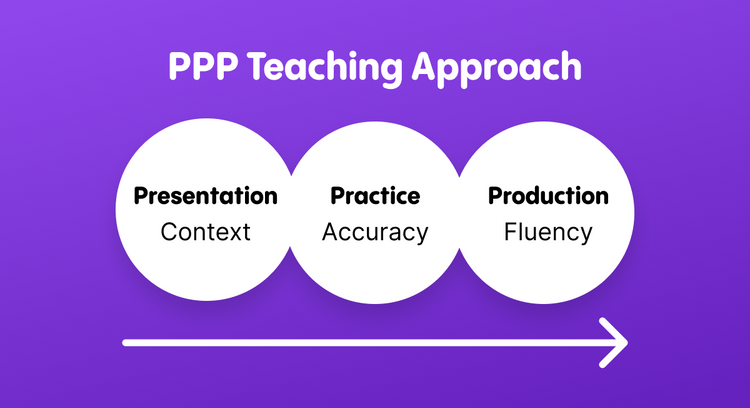Teaching English to kids can be a challenging task, especially when they are not native speakers of the language. However, English lessons can be an enjoyable and rewarding experience for both teachers and students. One teaching methodology that has been found effective in teaching English to kids is the PPP (Presentation, Practice, Production) method.
The PPP method is a popular teaching approach used in many English language teaching (TEFL) classrooms around the world. This approach is based on the communicative approach to teaching a language, which emphasises the importance of communication as the ultimate goal of language learning. The PPP method involves three stages: presentation, practice, and production. AllRight.com offers a range of resources for teachers, including lesson plans, activities, and articles on teaching methodology teachers can use in their own classes using the PPP method.
Advantages of the PPP Method
The PPP method has several advantages that make it an effective approach to teaching ESL:
It provides a systematic and structured approach to language learning that emphasises the importance of presentation, practice, and production.
The method ensures that students have a clear understanding of the new language concepts and are given ample opportunity to practise and apply them.
It provides a variety of learning activities that cater to different learning styles and preferences. Visual, auditory, and kinesthetic learners can all benefit from the PPP method.
The PPP method fosters a positive and engaging classroom environment that encourages student participation and interaction. It allows students to learn in a supportive and collaborative environment, which can increase their motivation and engagement.
Presentation
The first stage, presentation, is where the teacher presents new information to the students, such as a new grammar point or a vocabulary list. It is important that the information is presented in sufficient detail and in a clear visual context, using pictures or flashcards to help illustrate the meaning of words and grammar.
There are 4 key points that should be occurring in an effective classroom presentation:
1. Your presentation stage should last no more than 5 minutes;
2. Creating a clear visual context (Use simple pictures to present the meaning of words and grammar. For vocabulary, this can be as simple as using flashcards. For grammar, try to think of a simple picture that can represent the meaning and context of grammar part)
3. Oral presentation first, written second (Present grammar orally first, using a clear, visual context. After you have presented it this way, only then write the full form on the board for the students to see. In this way you have given the word's meaning first, and it will allow the students to make connections between what they have heard and seen. The written form should be erased slowly through the practice stage)
4. Use CCQs (Never ask a student “Do you understand?” You need to check that they understand, using Concept Checking Questions (CCQs). CCQs should be framed as a yes / no question, or as a closed question with two options)

For example, the teacher may show the class the following picture and model the following sentences:
Mr Smith is making breakfast.
Mr Smith IS makeING breakfast.
Mr Smith …IS make…ING breakfast.
Mrs Smith is looking at her laptop.
Mrs Smith IS lookING at the laptop.
and so on. She might then write the sentences on the board and perhaps describe the grammar rule.
Practice
The second stage of the PPP method is practice, where students drill and reinforce the new language through various activities. This stage can be longer or shorter depending on the complexity of the new language being taught and the needs of the students. Worksheets or games can be used during this stage to make the practice more engaging and interactive. AllRight.com provides a variety of materials for teachers to use during the practice stage of the PPP method, making the learning experience more engaging and interactive. You can use dice with verbs to practise speaking with younger children. Check them out here.
The practice contains multiple activities to approach the entire class. There’s a good chance that this will take up more time than any other phase of the PPP method. However, drilling can also be brief if the new language is simple and easy for a particular class to grasp. At this point, it is up to the teacher to determine the best course of action based on the needs of the students.
Production
The final stage of the PPP method is production, where students use the new language they have learned to synthesise new examples, either in written or spoken forms. This can be challenging for low-level beginners or extremely young learners, so additional practice may be needed until they obtain a firm foundation in English.
The PPP method is just one of many teaching methods that can be used in ELT. Other popular methods include the Communicative Approach, Task-Based Language Teaching, and Content-Based Instruction. Each method has its own advantages and disadvantages, and it is up to the teacher to choose the method that suits the students' needs best.
If you are interested in learning more about the PPP method and other teaching methodologies in ELT, there are many resources available online. And as previously mentioned, AllRight.com is an excellent source of information, providing a wide range of resources for teachers, including lesson plans, activities, and articles on teaching methodology.
In conclusion, the PPP method is a popular and effective teaching method for teaching English as a Second Language to children. By following the three stages of Presentation, Practice, and Production, teachers can help students to better understand and use the new language they are learning.









